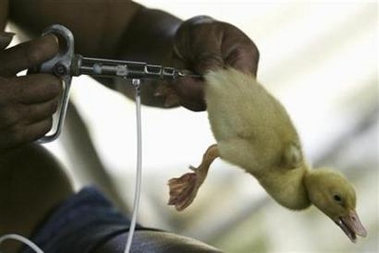Bird flu virus mutating into human-unfriendly form
Updated: 2007-10-09 06:35
NEW YORK -- The H5N1 bird flu virus has mutated to infect people more easily, although it still has not transformed into a pandemic strain, researchers said on Thursday.
 A worker injects a duckling with the bird flu vaccine at a duck farm following an outbreak of bird flu, in Panyu district of Guangzhou, south China's Guangdong province, September 18, 2007. The H5N1 bird flu virus has mutated to infect people more easily, although it still has not transformed into a pandemic strain, researchers said on Thursday. [Agencies] |
The changes are worrying, said Dr. Yoshihiro Kawaoka of the University of Wisconsin-Madison.
"We have identified a specific change that could make bird flu grow in the upper respiratory tract of humans," said Kawaoka, who led the study.
"The viruses that are circulating in Africa and Europe are the ones closest to becoming a human virus," Kawaoka said.
Recent samples of virus taken from birds in Africa and Europe all carry the mutation, Kawaoka and colleagues report in the Public Library of Science journal PLoS Pathogens.
"I don't like to scare the public, because they cannot do very much. But at the same time it is important to the scientific community to understand what is happening," Kawaoka said in a telephone interview.
The H5N1 avian flu virus, which mostly infects birds, has since 2003 infected 329 people in 12 countries, killing 201 of them. It very rarely passes from one person to another, but if it acquires the ability to do so easily, it likely will cause a global epidemic.
All flu viruses evolve constantly and scientists have some ideas about what mutations are needed to change a virus from one that infects birds easily to one more comfortable in humans.
Birds usually have a body temperature of 106 degrees F, and humans are 98.6 degrees F usually. The human nose and throat, where flu viruses usually enter, is usually around 91.4 degrees F.
"So usually the bird flu doesn't grow well in the nose or throat of humans," Kawaoka said. This particular mutation allows H5N1 to live well in the cooler temperatures of the human upper respiratory tract.
H5N1 caused its first mass die-off among wild waterfowl in 2005 at Qinghai Lake in central China, where hundreds of thousands of migratory birds congregate.
That strain of the virus was carried across Asia to Africa and Europe by migrating birds. Its descendants carry the mutation, Kawaoka said.
"So the viruses circulating in Europe and Africa, they all have this mutation. So they are the ones that are closer to human-like flu," Kawaoka said.
Luckily, they do not carry other mutations, he said.
"Clearly there are more mutations that are needed. We don't know how many mutations are needed for them to become pandemic strains."
|
|
|
||
|
||
|
|
|
|